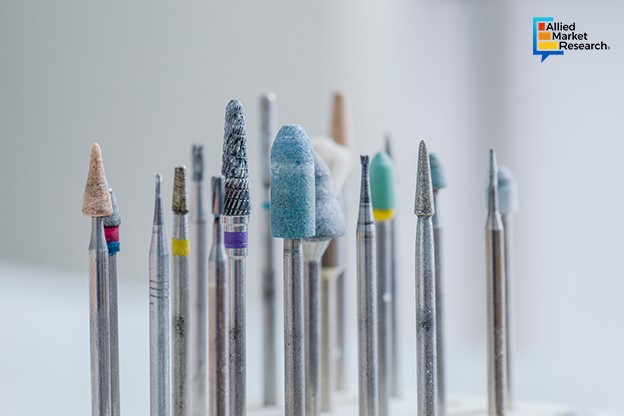Precision Tools Shaping Dental Procedures: Grinding and Polishing Burs

26 May
2025
Highlights:
- Introduction
- Advanced Materials & Designs
- Tech & Safety Upgrades
Dental grinding and polishing burs are important tools that support a wide range of dental procedures such as cutting, shaping, contouring, and finishing. These tiny rotary instruments may look simple, but their role in day-to-day clinical dentistry is significant. Dentists rely on them for procedures from cavity prep to intricate restorative work. With high-end advancements in design and material science, burs are now expected to deliver better performance, longer durability, and greater comfort for both clinicians and patients.
Evolving Materials and Designs in Daily PracticeDental burs used to be made from stainless steel or carbide, but now better materials are being used. Today, diamond-coated burs are being used more widely due to their superior hardness and precise cutting ability. These burs are particularly useful in cosmetic and restorative procedures where accuracy is everything. Their high durability also means that dental clinics can reduce the frequency of tool changes, helping improve the efficiency of patient care. Additionally, with minimally invasive techniques gaining traction, ultra-fine burs are becoming more common. These designs allow for more conservative enamel removal and better preservation of natural tooth structure, which is now a core principle in modern dentistry. The dental grinding and polishing burs industry accounted for $487.84 million in 2023 and is predicted to gather a revenue share of $756.35 million by 2032, rising at a CAGR of 5% during 2024-2032.
Digital Integration is Reshaping Product ExpectationsThe rise of CAD/CAM systems and 3D printing in dentistry has led to a demand for burs that can work hand-in-hand with digital workflows. Dental technicians and clinicians now require grinding and polishing tools that can manage high-performance materials like zirconia, lithium disilicate, and hybrid composites. With digital impressions and milling becoming the new norm, burs are expected to provide precise outcomes in fewer steps. This shift is also making manufacturers engineer specialized burs optimized for use with robotic and automated dental tools. In fact, as highlighted in a recent LinkedIn industry analysis, robotic grinding and polishing systems are gaining ground not just in industrial settings but also in medical and dental fields, adding a new layer of precision and efficiency.
Infection Control, Sustainability, and Recent DevelopmentsThe need for reliable infection control in dental clinics has encouraged the use of single-use, pre-sterilized burs. This helps reduce the chance of cross-contamination and makes sterilization workflows faster and more manageable. At the same time, there's growing pressure on manufacturers to address environmental concerns. Dental burs, though small, contribute to clinical waste. In response, companies are exploring sustainable production methods and recyclable packaging to support broader goals around eco-conscious dental practice.
Recent industry updates reflect these directions clearly. In September 2023, 3M launched a new set of high-performance burs designed to last longer and cut more efficiently. Just a month earlier, Dentsply Sirona expanded its product capabilities by acquiring a company focused on advanced bur design, with an eye on regions showing rising procedural volumes. KaVo Kerr took a bold step by integrating artificial intelligence into their latest polishing burs, offering real-time feedback during use—something that could redefine clinical performance monitoring. Brasseler USA, known for its broad line of rotary instruments, secured regulatory clearance for a line of sustainable burs in June 2023, emphasizing its commitment to greener solutions. Around the same time, NSK Ltd. began scaling up its operations in India to meet growing demand across Asia for dental tools, including grinding and polishing burs. These moves show that the product line continues to evolve not only in performance but also in distribution and manufacturing scale.
Looking Ahead with Practical InnovationThe industry of dental grinding and polishing burs is responding quickly to practical demands from clinics and labs. Whether it’s using more digital tools, keeping clinics safer from infections, or making products that are better for the environment, manufacturers are working hard to keep up with these needs. For dental professionals, staying updated on product developments can lead to better decision-making and improved patient outcomes. With the gap between hand work and machine precision getting smaller, dental burs are becoming more advanced, more efficient, and better suited for today’s dental needs.
For more information on the key growth drivers and investment opportunities in the market, contact our experts here!

Koyel Ghosh
Author’s Bio- Koyel Ghosh is a blogger with a strong passion and enjoys writing in miscellaneous domains, as she believes it lets her explore a wide variety of niches. She has an innate interest in creativity and enjoys experimenting with different writing styles. A writer who never stops imagining, she has been serving the corporate industry for the last five years.
Avenue: Entire Library membership of Allied Market Research Reports at your disposal
- Avenue is an innovative subscription-based online report database.
- Avail an online access to the entire library of syndicated reports on more than 2,000 niche industries and company profiles on more than 12,000 firms across 11 domains.
- A cost-effective model tailored for entrepreneurs, investors, and students & researchers at universities.
- Request customizations, suggest new reports, and avail analyst support as per your requirements.
- Get an access to the library of reports at any time from any device and anywhere.
Related Post
-
How are Submarine Cables Transforming Global Connectivity with Enhanced User Experience?
-
Endoscopy Procedures: Transformations in Techniques and Applications
-
AI-Powered Video Analytics: How the Product Actually Works for enterprises
-
Painting Robots: Transforming Precision Coating and Creative Applications
-
Innovations in Pharmacovigilance Systems Advancing Patient Safety
-
Understanding Edge Security: Keeping Data Safe Near the Source
-
Exploring the Use and Advancements of 3D Laser Scanners in Professional Applications
-
Reinforcing Industrial Controls with Smarter Tools and Training








